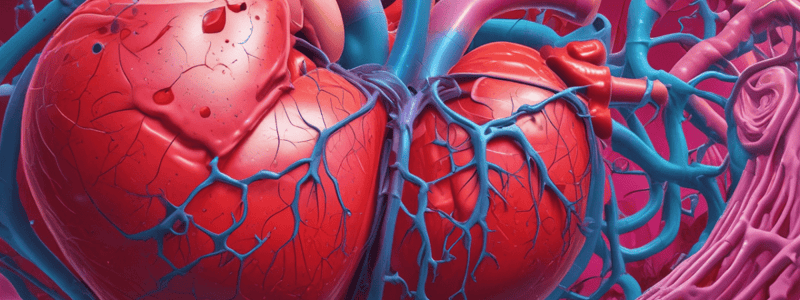Podcast
Questions and Answers
¿Cuál es el propósito del sistema de clasificación funcional NYHA?
¿Cuál es el propósito del sistema de clasificación funcional NYHA?
El propósito es evaluar la gravedad de los síntomas de insuficiencia cardíaca en los pacientes.
¿Cuántas clases hay en el sistema de clasificación funcional NYHA y qué evalúa cada una?
¿Cuántas clases hay en el sistema de clasificación funcional NYHA y qué evalúa cada una?
Hay cuatro clases en el sistema NYHA. La Clase I evalúa la falta de limitación en la actividad física; la Clase II evalúa una ligera limitación; la Clase III evalúa una limitación marcada; y la Clase IV evalúa síntomas en reposo.
¿Qué tipo de limitación experimenta una persona en la Clase II del sistema NYHA?
¿Qué tipo de limitación experimenta una persona en la Clase II del sistema NYHA?
Una ligera limitación de la actividad física. La actividad física ordinaria provoca fatiga, palpitaciones, dificultad para respirar o dolor en el pecho.
¿Qué indica la Clase III del sistema de clasificación NYHA?
¿Qué indica la Clase III del sistema de clasificación NYHA?
¿Cómo se describe la Clase IV del sistema NYHA?
¿Cómo se describe la Clase IV del sistema NYHA?
¿Qué se entiende por insuficiencia cardíaca sistólica?
¿Qué se entiende por insuficiencia cardíaca sistólica?
¿Cuál es la principal diferencia entre la insuficiencia cardíaca sistólica y la insuficiencia cardíaca diastólica?
¿Cuál es la principal diferencia entre la insuficiencia cardíaca sistólica y la insuficiencia cardíaca diastólica?
¿Qué es la insuficiencia cardíaca crónica?
¿Qué es la insuficiencia cardíaca crónica?
¿Cómo se caracteriza la insuficiencia cardíaca aguda?
¿Cómo se caracteriza la insuficiencia cardíaca aguda?
¿Por qué es importante la clasificación funcional NYHA en el tratamiento de la insuficiencia cardíaca?
¿Por qué es importante la clasificación funcional NYHA en el tratamiento de la insuficiencia cardíaca?
Study Notes
Overview
The New York Heart Association (NYHA) functional classification system is widely used to assess the severity of heart failure symptoms in patients. This system divides people with heart failure into four classes based on their ability to perform physical activities without experiencing severe symptoms. Understanding the NYHA functional classification can help healthcare providers tailor treatments and monitor the progression of heart failure.
NYHA Classification
The NYHA functional classification system was first proposed in 1928 and later revised in 1994 to create a more comprehensive evaluation tool. It consists of four classes that assess the level of physical activity a person with heart failure can tolerate:
- Class I: No limitation of physical activity
- Class II: Slight limitation of physical activity (ordinary physical activity results in fatigue, palpitations, shortness of breath, or chest pain)
- Class III: Marked limitation of physical activity (less than ordinary physical activity causes fatigue, palpitations, shortness of breath, or chest pain)
- Class IV: Symptoms of heart failure at rest (any physical activity causes further discomfort)
Healthcare providers assign NYHA classes to determine the best course of treatment and monitor changes in patient conditions over time.
Types of Heart Failure
Heart failure can be broadly divided into two main types:
- Systolic heart failure: Occurs when the heart cannot pump blood efficiently, leading to reduced output.
- Diastolic heart failure: Also known as restrictive cardiomyopathy, it occurs when the heart's muscle stiffens, making it difficult for the ventricles to fill with blood during relaxation.
Systolic Heart Failure
Systolic heart failure is characterized by reduced cardiac output and inadequate pumping function of the left ventricle. This leads to symptoms such as shortness of breath, fatigue, and fluid retention. Treatment often involves medications that improve contractility, reduce afterload, or enhance blood volume.
Diastolic Heart Failure
Diastolic heart failure occurs when the heart muscle becomes stiff and unable to fill effectively during relaxation. As a result, the ventricles are less able to pump blood efficiently, leading to symptoms such as shortness of breath on exertion, fatigue, and fluid retention. Treatment typically involves medications that improve myocardial relaxation, reduce afterload, or enhance blood volume.
Chronic Heart Failure
Chronic heart failure refers to the long-term management of heart failure symptoms with ongoing medical treatment and lifestyle modifications. It includes both systolic and diastolic heart failures and focuses on managing symptoms, preventing complications, and improving quality of life. While there is no cure for chronic heart failure, effective treatments can help patients live full lives with minimal impairments.
Acute Heart Failure
Acute heart failure is characterized by sudden cardiac decompensation, often triggered by acute illness, medication changes, or the progression of underlying heart disease. Symptoms may include severe shortness of breath, rapid weight gain, increased swelling, or irregular heartbeats. Urgent hospitalization is usually required to manage acute heart failure and may involve supportive care, medications, or invasive therapies (e.g., mechanical circulatory support).
In conclusion, understanding the NYHA functional classification system can help healthcare providers tailor treatment strategies for patients with different types and stages of heart failure. By classifying patients into one of four categories based on their physical activity limitations, healthcare professionals can better understand the severity of a patient's condition and adjust treatments accordingly.
Studying That Suits You
Use AI to generate personalized quizzes and flashcards to suit your learning preferences.
Description
Aprende sobre la clasificación funcional NYHA que evalúa la gravedad de los síntomas de insuficiencia cardíaca y los tipos de insuficiencia cardíaca como la sistólica y diastólica. Descubre cómo los profesionales de la salud utilizan esta clasificación para personalizar tratamientos y monitorear la progresión de la enfermedad cardíaca.




